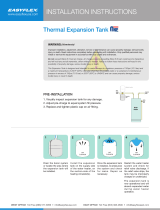
TABLE OF CONTENTS
3
INSTALLATION .................................................................................... 16
Required Tools and Materials .......................................................... 16
Installation & Start Up Tools ...................................................... 16
Service Tools ............................................................................. 16
Unit Placement ................................................................................ 16
Ceiling Suspension ................................................................... 16
Pad Mounting ............................................................................ 16
Electrical Connections ..................................................................... 17
Correct Voltage And Phase ....................................................... 17
Branch Circuit Disconnect Switch ............................................. 17
Transformer Conguration 208 VAC Models ............................. 17
Water Connections .......................................................................... 17
Installation Instructions ............................................................. 17
Single Tank Conguration ................................................................ 18
Two Tank Pre Heat Conguration .................................................... 18
Condensate Drain Line .................................................................... 18
Standard Tank Thermostat .............................................................. 18
Digital Tank Thermostat Installation ................................................. 19
Temperature Sensor Installation ...................................................... 19
Air Flow and Ducting ....................................................................... 19
Duct Sizing ................................................................................ 19
Duct Insulation .......................................................................... 19
Make Duct Connections ............................................................ 19
Building Air Pressure ................................................................. 19
When To Install Ducting ............................................................ 20
Supply Air Ducting ..................................................................... 20
Return Air Ducting ..................................................................... 20
Blower Assembly Adjustments ......................................................... 20
INSTALLATION CHECKLIST ............................................................... 22
START UP ............................................................................................ 23
Digital Tank Thermostat ................................................................... 24
MAINTENANCE AND SERVICE .......................................................... 25
Routine Maintenance ....................................................................... 25
TROUBLESHOOTING ......................................................................... 27
Checking Refrigerant Charge .......................................................... 28
Subcooling Calculation .............................................................. 28
Superheat Calculation ............................................................... 28
CONTROL SYSTEM ............................................................................ 29
Control Board ............................................................................ 29
Pressure Switches .................................................................... 29
Phase Monitor ........................................................................... 30
Compressor Overload Module .................................................. 30
Delay Timers ............................................................................. 30
How To Reset The Control System ........................................... 30
WIRING DIAGRAMS ............................................................................ 31
Thermostat And Accessory Wiring Diagrams .................................. 37
Digital Tank Thermostat Wiring ................................................. 37
Standard Tank Thermostat Wiring ............................................. 38
High Ambient Air Kit Wiring ....................................................... 39
Building Recirculation Pump Wiring Diagram ........................... 40
PIPING DIAGRAMS ............................................................................. 41
LIMITED WARRANTY .......................................................................... 47
TABLE OF CONTENTS .......................................................................... 3
SAFE INSTALLATION, USE AND SERVICE.......................................... 4
GENERAL SAFETY INFORMATION ...................................................... 5
Precautions ........................................................................................ 5
Grounding Instructions ...................................................................... 5
INTRODUCTION .................................................................................... 6
Qualications ..................................................................................... 6
Preparing For The Installation ........................................................... 6
Principle Of Operation ....................................................................... 7
The Refrigeration Cycle .............................................................. 7
Air Temperature Range...................................................................... 7
Water Temperature Range ................................................................ 7
Refrigerant Charge ............................................................................ 7
Equipment Disposal ........................................................................... 7
FEATURES AND COMPONENTS ......................................................... 8
Product Illustrations ........................................................................... 8
Rough In Dimensions ........................................................................ 9
Performance Specications ............................................................... 9
INSTALLATION REQUIREMENTS ...................................................... 10
Water Temperature .......................................................................... 10
Maximum System Temperature ................................................ 10
Inlet & Outlet Water Temperature .............................................. 10
Air Temperature ............................................................................... 10
Entering Air Temperature .......................................................... 10
Locating The Water Heater .............................................................. 10
Indoor Installation Only ............................................................. 10
Freezing Temperatures ............................................................. 10
Coastal Regions ........................................................................ 10
Heat Source .............................................................................. 10
Conditioned Space .................................................................... 10
Unconditioned Space .................................................................11
Clearances .......................................................................................11
Electrical Requirements ....................................................................11
Voltage & Amperage Ratings .....................................................11
Minimum Circuit Ampacity & Maximum Fuse Size .................... 12
Minimum Wire Size ................................................................... 12
Water Piping .................................................................................... 13
Maximum Pipe Length .............................................................. 13
Minimum Pipe Size ................................................................... 13
Pipe Support ............................................................................. 13
Pipe Insulation ........................................................................... 13
Cold Water Supply .................................................................... 13
Water Pressure ................................................................................ 13
Closed Water Systems .................................................................... 13
Thermal Expansion .......................................................................... 13
Mixing Valves ................................................................................... 13
Condensate Removal ...................................................................... 14
Contaminated Water ........................................................................ 14
Temperature - Pressure Relief Valve ............................................... 14
Tank Selection ................................................................................. 14
Contaminated Air ............................................................................. 14
Storage & Handling ......................................................................... 15




















